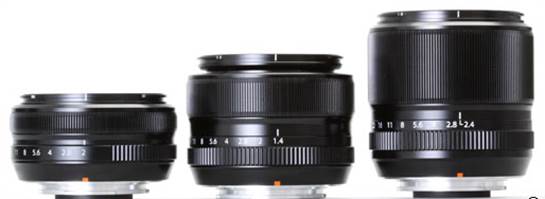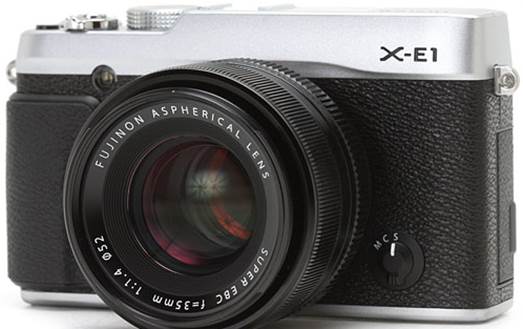Prime
lenses (fixed focal length)
The 18-55mm zoom is very cute and extremely
convenient but it is not your unique option. Fujifilm's XF prime lenses are
marvelous, and we spent a lot of time with them during the shooting for this
review. It is worth noting that all four of the XF primes’ weight is lighter
than the 18-55mm zoom. In the pictures below, all taken from the same location,
we have expressed the vision of each of the current XF series primes.

XF
14mm (21mm equivalent)

XF
18mm (27mm equivalent)

XF
35mm (52mm equivalent)

XF
60mm (90mm equivalent)
The
original XF lenses - 18mm F2, 35mm F1.4, 60mm F2.4 macro
These three lenses have persisted from the
beginning of the X series. As shown below, from left to right are 18mm F2, 35mm
F1.4 and 60mm F2.4 Macro (providing the 0.5x magnification). The 18mm Lens
highlights an unusually short back-focus design, with a wide diameter rear part
that juts out behind the rear of the mount.

18mm
F2, 35mm F1.4 and 60mm F2.4 Macro
All three of these lenses offer an
impressive mix of wide maximum aperture and respectively compact size; even the
largest is also smaller than the Carl Zeiss Sonnar E 24mm F1.8 of Sony for the
NEX system, and the 35mm F1.4 is a little shorter than the Leica Summilux DG
25mm F1.4 of Panasonics in spite of covering the larger APS-C sensor. All of
the lenses include circular aperture diaphragms for attractive presentation
out-of-focus backgrounds.
Lens hoods
All lenses come with skillfully crafted
metal hoods – the ones for the 18mm and 35mm have rectangular hood shapes,
while the 60mm has a deep round hood. Unfortunately, however, it seems to have
chosen the actual backseat in their design; the hood of the 60mm is so deep
that it is almost impossible to replace the lens with the hood reversed, and
because the front is anyway deeply recessed, so we always leaves it at home
(which we would rather leave at home than deny that there is one)

The
original XF lenses come with their hoods, from left to right 18mm F2, 35mm F1.4
and 60mm F2.4 Macro. Because the hoods of the 18mm and 35mm are irreversible,
they take up more space in your bag.
All three hoods use the same appropriate
bayonet and can be fixed on any of the lenses. Interestingly, the 35mm hood
does not vignette on the 18mm.
While the rectangular hoods are unable to
be used with standard round clip-on lens hoods, but instead of requiring
flexible push-on hoods, which tend to fall down. There are no hoods that fit
specifically for use with polarizing filters (known as unique lens filters that
still are used with digital perfectly).

This
is the brother of X-E1, the X-Pro1 with fixed lenses labeled the 18mm, 35mm and
60mm when you pack them for transporting. The rectangular hoods for the 18mm
and 35mm add more for transporting and cannot be used with conventional clip
hoods, while the 60mm’s hood is deeply impractical.
XF
35mm F1.4 R

XF
35mm F1.4 R
If we could only have one lens with the
Fujifilm X-E1, it would be the 35mm F1.4, which on both of the X-E1 and the
X-Pro1 would give a 35mm equivalent view. It is not only beautiful to hold, but
also the XF 35mm F1.4 has superior ability of taking portraits in low light and
soft, charming bokeh. It's obviously not as flexible as the 18-55mm zoom, but
it is sharp, lightweight and has large maximum aperture with a lot of creative
potential.

Combined
with the low light capabilities of the X-Trans sensor, we discovered that the
XF 35mm F1.4 was worth carrying anywhere. This informal portrait was taken in
the light of a reddish table lamp. 1/100, F1.4, ISO 1600
New
XF 14mm F2.8 R
Announced along with the X-E1, the XF 14mm
F2.8 R lens supplements an even wider fixed option for XF lens series. Combined
with a push-pull ring mechanism to switch between autofocus and manual modes,
which we first saw on the Olympus 12mm f/2 lens, the 14mm F2.8 lens is
equivalent to the 21mm lens on a 35mm camera in terms of vision. We will issue
a report in testing this lens in more detail in the shortest time.

With
the sliding lens ring pressed forward, the focus indicators are hidden and the
lens is in autofocus mode. The lens rings is not open.

Slide
the ring to the back to unveil the focus indicators and focus adjustment.
Lens
roadmap
In 2012, Fujifilm released a roadmap for
lenses it plans to launch in spring 2013, including three image-stabilized lens
zooms, a fixed ultra-wide lens, a "thin" normal lens and an 85mm F1.4
equivalent portrait lens. The two were launched with the X-E1 (the 14mm and
18-55mm). The remaining lenses are listed below. That is an interesting list of
Fujifilm's commitment to building a complete, diversified system.
Lens
·
27mm F2.8 fixed lens 41mm thin (35mm-equivalent
FL)
·
23mm F1.4 thin fixed lens, semi-wide 35mm
(35mm-equivalent FL)
·
55-200mm F3.5-4.8 OIS telephoto zoom of 83-300mm
(35mm-equivalent FL)
·
56mm F1.4 fixed lens attached 84mm short
telephoto (35mm-equivalent FL)
·
OIS 10-24mm F4 wide-angle zoom of 15-36mm
(35mm-equivalent FL)